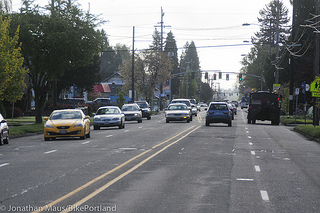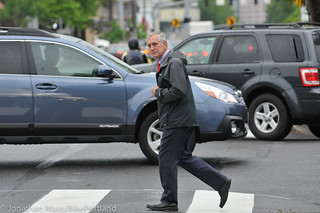Mayor Charlie Hales seems to be advancing an idea that’s been on advocates’ wish list for years: putting the City of Portland, not state government, in charge of the city’s biggest streets.
In an interview with The Oregonian editorial board last week, the paper reported, Hales said he “will formally propose local management” for “what are now state highways like Powell Boulevard.”
Other state-run roads in the city include the busy corridors of Southwest Barbur Boulevard, 82nd Avenue, Lombard Street, Southeast McLoughlin Boulevard and Southwest Macadam Avenue.
If that happens, it’d set a new direction for these onetime highways enveloped by the city.
These streets have been owned and kept up by the Oregon Department of Transportation since the days before interstate highways became the most popular way of moving across the metro area, but never transferred because neither the city nor state wants to spend the money to bring the roads up to city standards with comfortable sidewalks, smooth pavement and safer crossings.
Though such a change may sound bureaucratic — especially to taxpayers in general, who would be paying the bills either way — it’d be likely to have a big impact on how the roads develop, because ODOT’s incentives and culture are so much more focused on rapid car movement than the Portland government’s.
This fall, when ODOT was under pressure from the city to more seriously consider the possibility that adding bike lanes to Barbur Boulevard could be done without substantial loss of road capacity — something a lead engineer on the project says is possible — regional ODOT executive Jason Tell replied that ODOT is “open to” handing over control if only “funding [could] be identified for improvements.”
ODOT’s road system, after all, faces the same paralyzing maintenance backlog that Portland does and would be happy to unload some of those obligations.
So if Hales is publicly open to such possibilities too, that’s a sign of progress. But it’s far from a deal.
In an email last week (responding to a rumor we’d heard a few weeks ago that these conversations were active), City spokesman Dylan Rivera downplayed the chance that these transfers will actually happen.
“Mayor Hales and Commissioner Novick have said they are interested in taking over all the streets in the City of Portland,” Rivera confirmed. “The city naturally would want to control all streets in the city limits. In addition, city design standards are more appropriate for the urbanized communities that have grown up around what were once considered highways.”
But Rivera added: “Historically, we have done relatively few transfers. They are rare for many reasons. They’re very expensive. We don’t want to accept anything that’s going to be a burden on the city. So before we accept a transfer, we inspect the pavement, the striping, the traffic signals, sidewalks – everything about the facilities. We try to figure out how much it would cost to bring the street up to city standards. Often, we’re taking on streets that need millions of dollars in work.”
Until Hales or Novick actually make a more formal proposal, it’s hard to know what’s going on here. Hales, after all, was responding to a string of East Portland street fatalities and an excellent Oregonian series detailing the city’s planning failures in the area. He was under pressure to say something — and he doesn’t seem to have given himself a deadline for execution.
We’ll continue to report on this issue. Meanwhile, the many Portlanders who use these streets regularly and are eager for them to be improved might keep two things in mind:
1) Transfers like these have happened before. As Tell noted in his letter, the success stories include inner Martin Luther King Boulevard and Grand Avenue, inner Sandy Boulevard and Interstate Avenue.
2) Both Powell and Barbur are proposed as future TriMet routes. The money that upgraded Interstate Avenue and allowed the city takeover there came from TriMet’s Yellow Line project. In his letter, Tell hinted that a high-capacity bus or rail line along Barbur, currently planned as part of the Southwest Corridor project, could do the same.
But are mass transit projects the only way to finance streets that are more human-friendly? We may find out.



